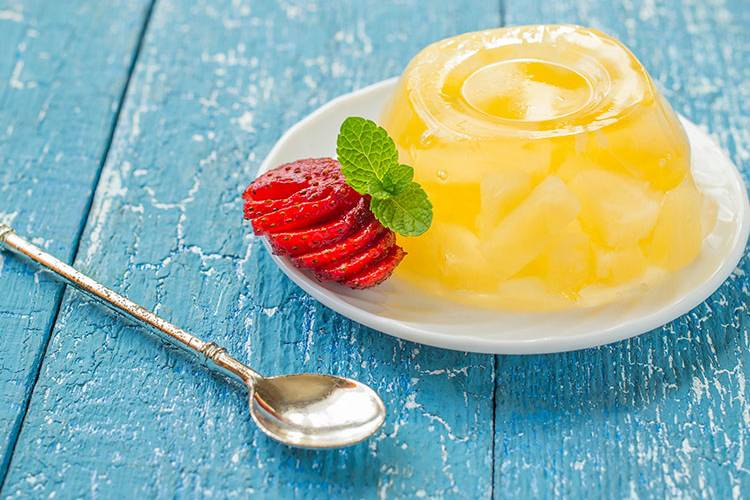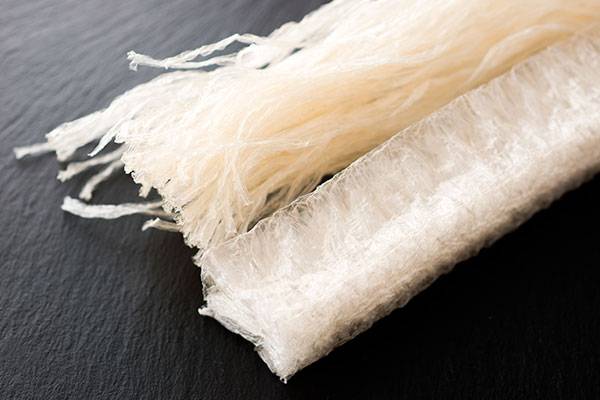What is vegetable gelatin?
Vegetable gelatin is an alternative to traditional gelatin that is gaining more and more weight in the preparation of desserts and vegan and vegetarian diets. Do you know how to make vegetable gelatin with agar-agar? We tell you how to use this seaweed as a natural gelling agent to give consistency to your recipes.
how to shop
Share

Vegetable gelatin, also known as agar-agar, is obtained mainly from red algae, making it suitable for vegetarians and vegans. Today we can find this product in the supermarket; various oriental food shops; nutrition stores and herbalists, although the most common is to find it in the form of powder or fibers, with which vegetable gelatin is made. Are you interested in discovering what vegetable gelatin is, its differences with animal gelatin and how to prepare it at home? Take note!
Types of gelatin
Neutral gelatin is a substance that is used above all in confectionery to give consistency to desserts. There are two types of gelatin: animal gelatin and vegetable gelatin.
• Animal gelatin: it is the one that has traditionally been used in Western cuisine. It comes from the collagen of bones and cartilage of animals due to the effect of cooking and is very nutritious since 90% is protein. It is still the most used today, but due to the increase in the population that does not consume products of animal origin, vegetable gelatin has an increasing presence.
• Vegetable gelatin: this is a mucilaginous substance of non-animal origin, since it is obtained from some types of algae, such as the red algae known as agar-agar. It is a colorless and tasteless substance that, once it comes into contact with liquids, can absorb up to more than 100 times its weight, giving rise to a jelly. Unlike animal gelatin, it is capable of gelling hot liquids, which is why it is highly valued in gastronomy. In addition, it is a good culinary alternative for vegans or vegetarians.
Benefits of vegetable gelatin
Like most edible algae, agar-agar has many nutritional benefits for our health, discover them all!
1. Helps fight constipation: agar-agar is one of the foods with the highest percentage of fiber, specifically 90% of its composition, which helps fight constipation.
2. Promotes weight loss: containing practically no calories (26 kcal/100 g), it is a very suitable ingredient for most weight loss diets, since it contains few carbohydrates, sugars and salt. In addition, it has a great satiating power.
3. Helps reduce cholesterol and blood glucose: the soluble fibers contained in agar-agar or vegetable gelatin are also beneficial for reducing cholesterol and blood glucose because they help absorb fats and sugars.
4. Helps maintain bones: vegetable gelatin is a source of B group vitamins, vegetable protein and minerals such as potassium (226 mg /100 g), iron (1.9 mg), magnesium (67 mg) and calcium. (54 mg), minerals that help prevent joint and bone diseases.
Vegetable gelatine, also known as agar-agar, is obtained mainly from red algae, making it suitable for vegetarians and vegans

What is agar agar?
Agar-agar is a natural gelling agent that comes from red algae. The origin of agar-agar is Japanese, it was discovered in the 17th century. In Japan it is called 'kanten', also known as the food of the gods. The word agar-agar has Malay origin, because it was Malaysia that adopted the product for commercial purposes and distributed it in the West.
In addition to being the best option for vegans and vegetarians, the best thing about agar-agar is its versatility, since it does not add color; smell; no flavor, it only modifies the texture of the food. On the other hand, its caloric content is very low and thanks to its high capacity to absorb liquids, many people include it in their diet to “trick the stomach”, due to its satiating effect.
How to make vegetable gelatin with agar-agar
To prepare vegetable gelatin with agar-agar, we recommend buying it in powder form in order to better control the amount we use. Making vegetable gelatin is very simple, you just have to follow these steps:
1. Add the agar-agar to the liquid with which we want to make a jelly.
2. Bring the liquid to a gentle boil for 2 minutes, stirring constantly to prevent lumps from forming.
3. Let it cool down.
4. Protect the gelatin in the fridge for the hours indicated in the recipe.
How much agar-agar should be used to make gelatin?
The amount will depend on the result we want to obtain. The more agar-agar we add to the liquid, the more consistent the mixture will be. For a soft gelatin, 4 g of agar-agar powder should be added per litre, but if we are looking for a vegetable gelatine with a hard texture, we will have to add up to 10 g per litre.
Other uses of agar-agar
• As a thickener: agar-agar can not only be used as vegetable gelatin, it is also used as a thickener. If the concentration of the algae is lower, we can use it to thicken a stew, a custard, a cream, an ice cream or a sauce.
Eye! If we want to use agar-agar as a thickener, the liquid should not come to a boil, we simply have to put whatever we want to thicken on a minimum heat and dissolve the amount indicated in the recipe.
• In salads: agar-agar can also be taken in a salad as one more ingredient to take advantage of all its properties.
Recipes with vegetable gelatin
Jelly Fruits
Ingredients
• 1l of water
• 150 g of sugar
• 6 g of agar-agar
• Chopped fruit (your choice)
Step by step recipe
1. Mix the sugar, water and agar-agar to get your vegetable gelatin.
2. Choose a mold and place the first layer of fruit.
3. Pour the already dissolved gelatin until it covers completely.
4. Put the mold in the fridge for about 20 minutes or until the gelatin is completely solidified.
5. Repeat the process two more times… With different fruits!
Tricolor pudding
Ingredients
• 200 g of yellow peppers
• 500 g of spinach leaves
• 200 g of cooked beetroot
• 100 g of courgette
• 12 g of agar-agar
• 400 ml of milk
• 1 plain yogurt
• 100 g of blue cheese
•Olive oil
•White pepper
•Salt
Step by step récipe
1. Wash the peppers and roast them on a baking tray.
2. Wash the spinach and zucchini and cut the zucchini into slices.
3. Sauté the zucchini in a pan. When it begins to soften, add the spinach and when they are cooked, season the vegetables.
4. Puree the vegetables until you get a fine puree. Do the same with all the vegetables. eye! Remember to peel the roasted peppers and courgette first.
5. Boil the milk with salt, pepper and the agar-agar. Let this mixture cool down a bit and pour a third part with the spinach puree, another third with the pepper puree and the last with the beet puree.
6. Pour the beet puree into a rectangular mould. Let cool and store in the fridge for 10 minutes. Pour the pepper puree on top and carry out the same process. Later, pour in the spinach puree and follow the same procedure.
7. Bring the pudding to temperature and unmold it.
8. Make the cheese sauce to accompany it, how? blending a natural yogurt with a tablespoon of olive oil and the blue cheese of your choice.
Jelly rolls with asparagus
Ingredients
• 100 ml soy sauce
• 100 ml of water
• 1 tablespoon dry sherry
• 4 g of agar-agar
• 1 block of tofu
• 2 bunches of wild asparagus
• 1 roasted red pepper
• 2 teaspoons of sesame
•3 tablespoons olive oil
•Salt
Step by step recipe
1. Heat the soy sauce with the water and cognac, and dissolve the agar-agar.
2. When the vegetable gelatin has solidified, spread it on a tray forming a thin layer and let it set in the fridge for 30 minutes.
3. Cut the tofu into eight strips and marinate it in soy sauce for ten minutes.
4. Clean the asparagus, remove the base and peel lightly. Boil them for seven minutes and reserve them.
5. Cut the jelly into eight rectangles, place three asparagus spears and two tofu strips on each, and roll them with the jelly. Wrap each roll with a strip of pepper and decorate with sesame.
6. The remaining pepper, crush it with olive oil and salt, and serve it






